This time, we explore the appeal of OOH (Out Of Home: a collective term for advertising media encountered outside the home, such as transit ads, outdoor billboards, and ads in commercial facilities), which continues to evolve daily, through an interview. We spoke with Mr. Nagaaki Onoe, a planner and creative director at Dentsu Inc. who has handled numerous high-profile OOH projects, along with Mr. Daiki Kurokawa and Ms. Kana Misawa from the company's Out-of-Home Media Division.
Mr. Onoe describes OOH as a "recommendation engine" that introduces products and services to people walking through the city. He shares the unique value of OOH, distinct from other advertising, while discussing creative work he has personally handled.
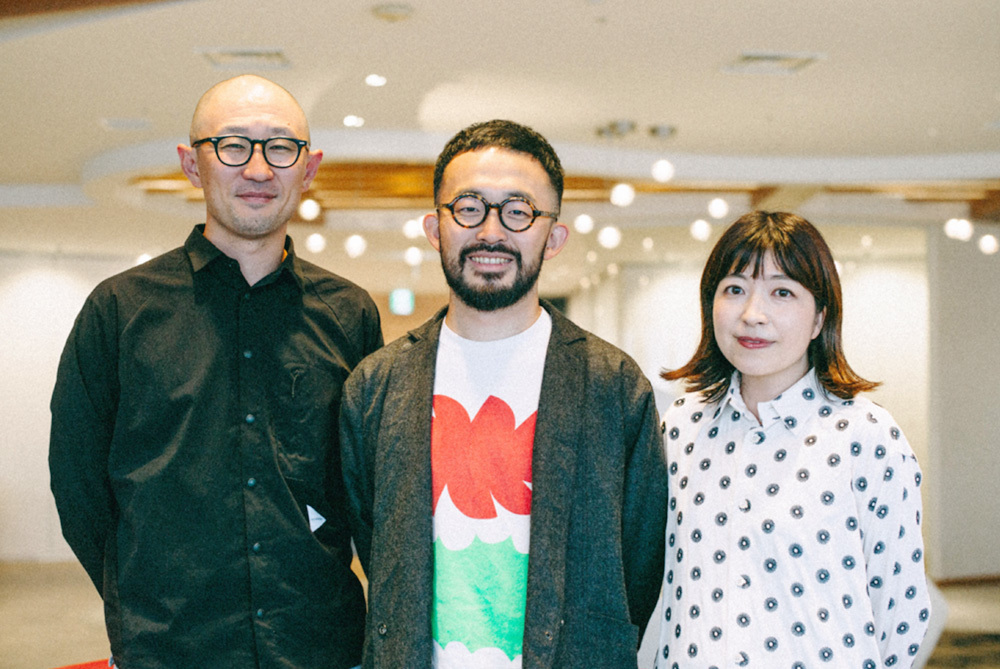
From left: Daiki Kurokawa, Out-of-Home Media Division; Nagaaki Onoe, Planner/Creative Director; Kana Misawa, Out-of-Home Media Division
OOH is a "hero media" that powerfully drives campaigns
Misawa: First, the OOH promotion for Netflix's sumo drama "Sanctuary" in May 2023 generated significant buzz. How did this project come about?

The "Giant Saru-O" OOH case for "Sanctuary". A powerful installation where the drama's protagonist, Saru-O, appears as a giant relief lying at JR Ryogoku Station.
Onoe: When planning campaigns, we used to center our promotional strategy around the company's homepage. Whether it was conveying the full scope of the campaign or getting people to see the tagline, the homepage or its dedicated campaign site was the main focus, built around driving traffic there.
However, starting around 2014, more content became available solely through SNS, making it harder to get people to thoroughly view the homepage. The barrier to getting them to click or tap once keeps rising. So, we want to convey everything in the first view as much as possible.
This is why newspapers and OOH (Out-of-Home advertising) became the focal points for campaign visibility. OOH, in particular, serves a dual purpose: the photographed images get posted and shared on SNS, acting as thumbnails. Its greatest strength is the ability to visually present talent and catchphrases in a thumbnail-like format while also establishing the placement location as a landmark for that campaign.
Looking at circulation data ("sanctuary -聖域-"), some suggested we should send a strong message in Shibuya rather than Ryogoku, the sacred ground of sumo. But that felt like it would lack punch. With the May Grand Sumo Tournament happening, I thought we should definitely do it in Ryogoku.
From various proposals, we chose to create a giant monkey cherry blossom—something impactful yet not overly difficult to produce.
Misawa: This OOH campaign truly became an advertising case study that created a landmark, proving it could generate buzz even outside Shibuya or Shinjuku. Social listening showed many people actually went to see it.
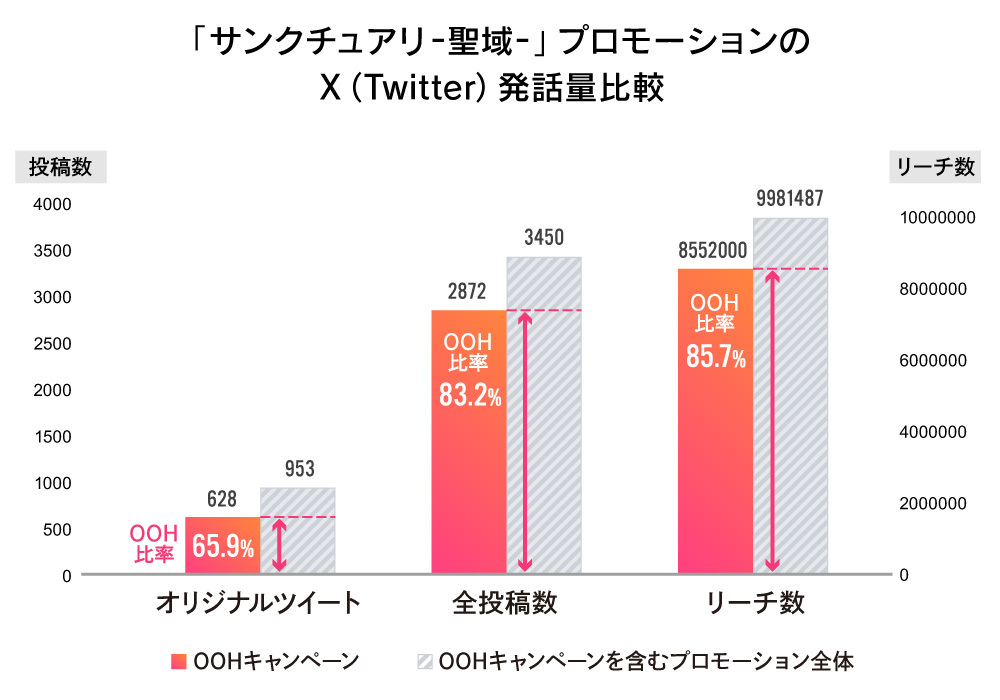
Research: Dentsu Inc. Research Tool: Meltwater Research Period: May 7 - June 4, 2023
Onoe: The drama's content was also good, so I think some people went to see it after streaming began. We've created various ads over the years, but ultimately, catchphrases and visuals are crucial. In the past, newspaper ads were the only way to concisely convey a brand's message of "This is what we're doing," but now OOH and X (Twitter) posts are also options.
Personally, I feel campaigns without OOH or X (Twitter) posts seem disorganized. OOH combines digital reach with on-site experiential power, making it a natural "hero media" to powerfully drive campaigns.
Kurokawa: "Hero media" is such a wonderful term. OOH becomes a hero because it raises awareness of products or services while also becoming a landmark in the city.
Onoe: Back in the Heisei era, it was conventional wisdom that OOH wasn't suited for long messages because people spent little time looking at it. But now, since people take photos with their smartphones and share them, having OOH that captures longer attention spans is actually a factor in becoming a "hero medium."
Precisely because digital information is proliferating, I believe it's better to use OOH to disseminate information and generate buzz during a campaign's launch phase.
Misawa: I see, that's a fresh perspective. Onoe-san, you're a creator skilled at designing integrated campaigns using digital, right? Are there other examples where you've deployed OOH tailored to specific locations?
Onoe: For the promotion when a new volume of "Here Comes the Neighborhood Watch" (Kochikame) was released after five years, we placed ads at JR Kameari Station, the setting of the manga. The manga's cover illustrations feature depictions of Kameari and the downtown area, so we created 12 different poster visuals that superimposed those scenes onto the actual scenery. We wanted people to feel like Ryōsan and the others had truly come back.
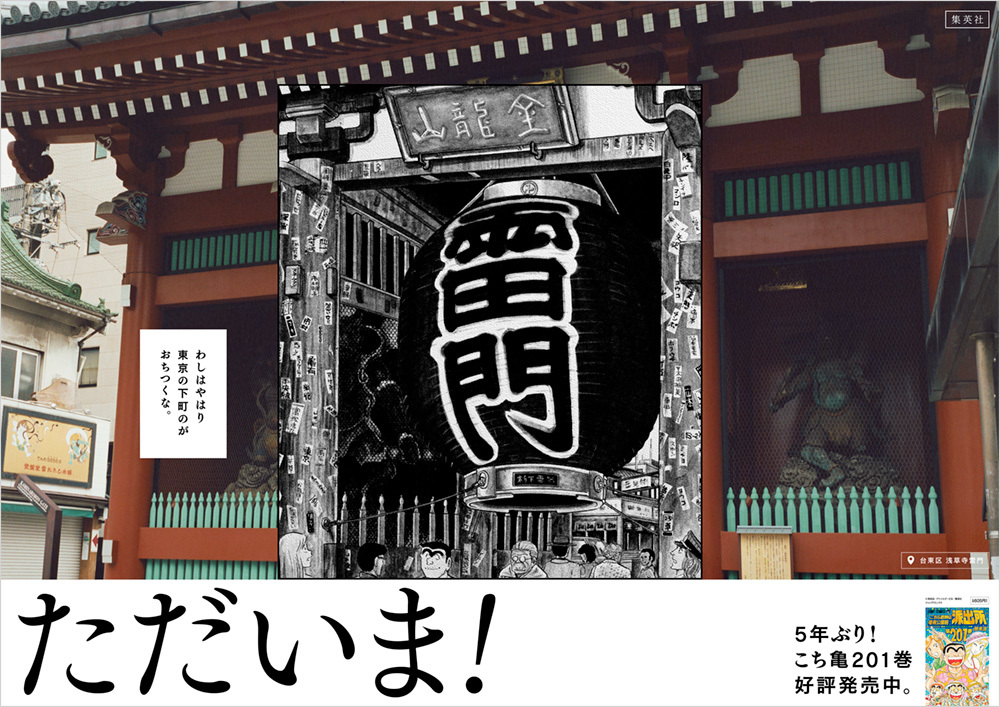
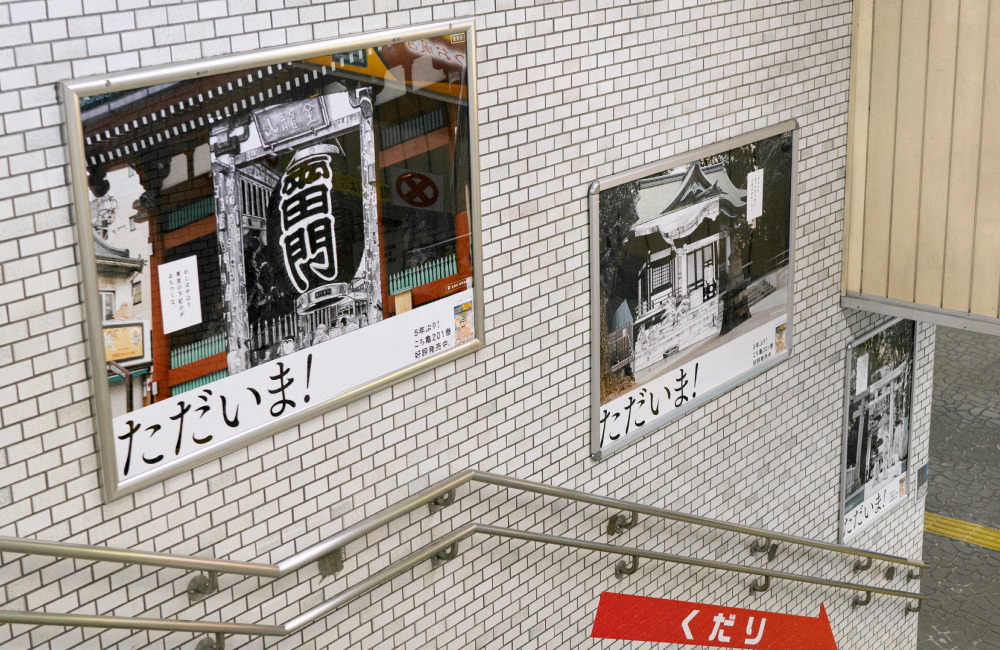
OOH for "Kochira Katsushika-ku Kameari Kōen-mae Hashutsujo" Volume 201. Overlays manga cover art onto the scenery of Kameari town.
Onoe: Another example is the ad takeover inside trains for Netflix's "Rilakkuma and Kaoru" (*1). This stop-motion anime series, with episodes around 10 minutes long, depicts the daily life of Kaoru, a protagonist often driven by various "should" pressures, who finds liberation through her cohabiting Rilakkuma companions.
The promotional ad deliberately selected catchphrases from everyday language that evoke a sense of "should." The response copy reads: "Isn't there too much pressure to try hard in this world? 10 minutes to forget about trying hard."
At the time, train advertisements were dominated by diet ads like "Lose weight by summer" and English conversation ads that made people feel they'd be left behind if they didn't study hard, creating a stifling atmosphere. Therefore, the intention was to liberate viewers of the "Rilakkuma and Kaoru-san" announcement ad from these "shoulds," just like Kaoru-san.
※1 Netflix Series "Rilakkuma and Kaoru" Now Streaming Exclusively
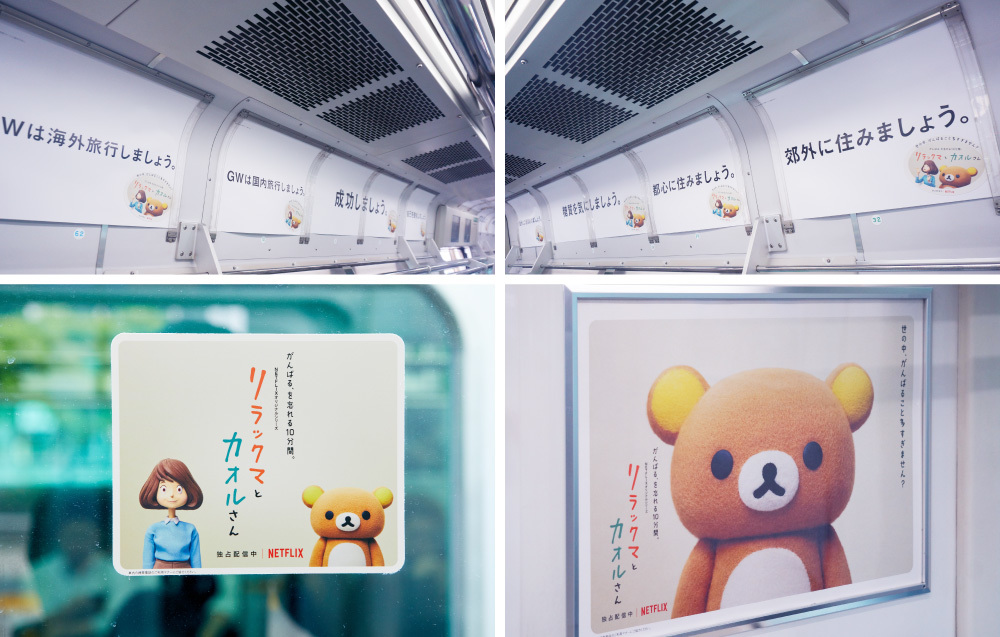
OOH Examples for "Rilakkuma and Kaoru-san"
Misawa: It critically examines common car interior ads while turning them into charming advertisements—almost like media art. Onoe-san's projects often feature many ad variations. Why do you change the artwork for each piece instead of reusing the same creative?
Onoe: Partly because I love the work, but also because as a fan seeing ads, I feel disappointed when I see the same creative repeated. I'm happier when there are lots of varieties. Reusing the same material also gives a strong impression of just trying to sell something. I recall seeing a huge number of ads at Shibuya Street Jack before, and all the anime illustrations were different. I thought fans would be thrilled. It made me excited just looking at them, and it created the fun of searching for them.
The more niche the OOH, the happier fans are
Onoe: Fans tend to appreciate OOH ads more when they're niche. They become memorable as a souvenir of visiting a famous spot, and some people even take photos to document them. Typically, ads are placed where they're easy to understand and see, but when the audience is fans, the more you hide it, the more its value increases, potentially boosting advertising effectiveness. It changes the conventional concept of advertising.
Kurokawa: That idea of value increasing the more you hide it is fascinating. What are some niche examples?
Onoe: The Donbei kettle is one such example. Previously, there was a shop called "Donbareya" on the Shibuya Station platform where you could eat Donbei. When that shop closed, they ran a campaign. All they did was quietly place a kettle and a handwritten note inside the closed shop. They didn't run a big advertising campaign, but photos of it spread online and became a huge talking point. I think it's precisely because it was so discreet that it created a sense of discovery, making people want to share it online with others.
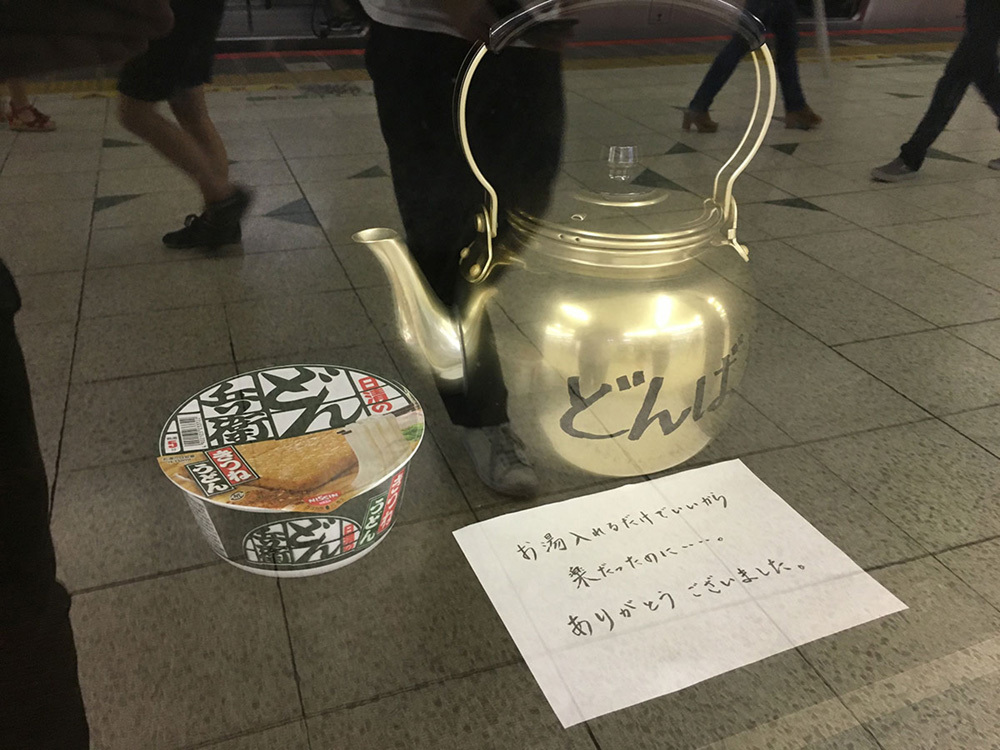
Closing notice for "Donbareya". A photo of the tables inside the shop taken through the glass door. A casual note left by the shop owner remains.
Onoe: For the 20th anniversary campaign of the manga "ONE PIECE," we placed advertisements featuring traces of the Straw Hat Crew, characters from the series, at 10 locations throughout Kyoto City. Some ads were placed in quite secluded spots, but I think these subtle details actually got the best reactions.
Misawa: When you find interesting OOH, you want to tell people about it, right? I can picture people sharing it on social media.
Onoe: A recent example is the OOH promoting the new packaging for Morinaga Milk Industry's coffee brand "Mount Rainier." The newly launched "Mount Rainier Black Unsweetened" switched from the traditional cup-shaped container to a paper carton with a cap, designed to enhance the enjoyment of its aroma. Since it's displayed on a different shelf from the existing products, it's harder to find. So, we deliberately planned OOH that encourages people to actively search for the product on the shelf. The poster shows many products, some of which look similar, but none are quite the same. We added playful touches, like including phrases on each product's packaging that hint at the new "Mount Rainier Black Unsweetened" joining the shelf.
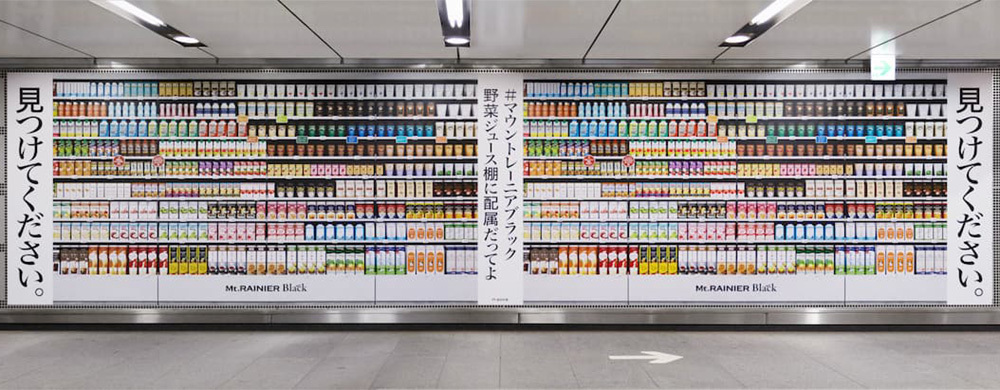
An advertisement for Mount Rainier's new packaging displayed at Shibuya Station. It turned the challenge of customers not noticing the product due to the changed display shelves into an opportunity, creating an ad that encourages people to find the new product.
Misawa: I hear fans tend to appreciate niche OOH more. How do you handle announcing the ad placements?
Onoe: It depends on the case. Sometimes we ask clients not to announce the ad placement. Announcing it beforehand creates a structure where everyone goes to check, diminishing the sense of discovery. We sometimes hold back information until the evening, waiting for someone to discover it first. We want the first discoverer to be a fan. For campaigns we're confident will generate buzz from the start and drive the campaign, it's fine to announce placement simultaneously. But for others, announcing later might be better.
OOH recommends interesting things outside your usual interests
Kurokawa: How do you view OOH as a medium, Onoe-san? Also, what do you keep in mind during planning and production?
Onoe: Digital-only campaigns can make a brand feel confined to the small screen of a smartphone, limiting its perceived scale. So, using OOH's physical size for advertising helps create a better overall balance. It's a gut feeling, but OOH is great because it seems targeted yet isn't, allowing it to reach a diverse audience.
Serendipity is hard to achieve digitally. Whether it's people you follow on social media, curated sites, or YouTube channels you subscribe to, you're only exposed to things you're interested in and only see what you like.
This is said to make us prone to the "echo chamber phenomenon" (※2). With the pandemic increasing online communication over real-world interaction, this tendency has only grown stronger.
Given this reality, social media algorithms are now changing to show users more information beyond their existing interests. Still, OOH as a medium inherently built on this principle remains fascinating. In essence, OOH acts as the "street recommendation engine," suggesting interesting things outside people's usual interests to those out and about.
I remember old TSUTAYA stores placing POP displays or booklets like "100 Classic Albums" next to rental shelves, which broadened my interests. My personal philosophy is that if you're going to do something, you want to spark interest even in those who aren't initially interested and have a positive influence.
When planning OOH, I also consider whether the ad fits well as part of the cityscape. I'm influenced by my favorite illustrator, Raymond Savignac, who believed "posters placed in the city should be something people can enjoy." And once an ad is displayed, I go to the location myself to see how it looks and who sees it. I notice many things, and observing people's reactions helps shape future projects.
Kurokawa: You really consider OOH from so many angles. Every point was compelling and inspiring. I'd like to start using the powerful terms I heard today, like "hero media" and "recommendation engine," when explaining the appeal of OOH.
Misawa: Hearing Onoe-san speak, I felt the depth of your practical OOH knowledge. Above all, it was clear you're a genuine fan of the works and products you advertise, driven by respect. I look forward to seeing more heartfelt, city-enhancing ads that skillfully utilize OOH.
※2 "Echo chamber" refers to the phenomenon on social media where users follow others with similar interests, leading to a situation where opinions posted on SNS are met with similar responses. This is likened to the physical phenomenon of sound reverberating in a closed, small room.


















